Notes from the Colours of Dance Principal
Growing up in Dance
As dance teachers, many children grow up with us, and our relationships with many individuals and families are decades long. In some instances they even grow across generational boundaries, which is very special.
Whether your time with us is long or short, we try to get to know you really well, so that we can help you be the best dancer and have the best experience of dance - whatever that looks like. A very important part of a young dancer's journey is moving through adolescence and dealing with puberty. This can be a tricky, confusing, exciting and revalatory time for anyone, and as a learner you need special understanding and support. At Colours of Dance we get this. As dance teachers we are very aware of the impact of puberty on our students as dancers during this period.
We are not clinicians, so please do check up on us with your own additional reading if you wish to. I offer these thoughts as a result of my experience and study, to add to your knowledge of your own child(ren), so you know how we will support your children in this important period of development.
You may or may not be aware of the impact of puberty on a student studying dance. It is my hope to give useful information so that you know your child is being well supported here when they are dancing. For each person, the particular experience of puberty is unique, so we have to watch and listen very carefully with no end of patience (!). All adolescents will experience the following at some point and in some way:
- A changing centre of balance - either constantly as a child grows slowly and steadily, or in fits and starts as a child has a growth spurt, then nothing for a while, then another spurt etc
- Inadequate or delayed peripheral sensation/response - neural pathways are also affected by growth, e.g. the pathway to the ends of a person’s toes might rather suddenly be 2cm longer so the message to 'point the toes’ might not get there on time for a week or two. The brain catches up, but there are often periods of delayed response.
- ‘Blur brain’ - pubertal growth affects the brain too. During this period, the brain is almost completely re-wiring itself. This can make our children seem less responsive & slower in processing information or a bit ‘away with the fairies’.
- Body changes - new hair in new places, new/different body odour, skin breakouts, changes in perspiration levels, sudden onset of emotions seemingly for no reason, new biological rhythms and cycles
- Changes in Feelings and Struggles with self-expression - both about oneself as well as others or the world - and these feelings can seem very much more intense, important and urgent than they have even been before. An increased desire to make their own choices and be different, alongside an often inability to articulate/find the words - this is exacerbated by the re-wiring that is happening in their brains.
- Increased need for Fuel - their bodies and brains are growing and working really, really hard, so they are hungry, ravenous beasts that need regular feeding!
The biological differences even between students of exactly the same age can be enormous. In dance classes at your child’s level, they are likely dancing with a broad range of peer age, as they have reached this level through skill and commitment on their own timetable. So whatever your child’s own maturity is, they may well be aware (even if they can’t articulate it) that some children in their class are starting to deal with some of the things on the list above.
In dance classes, we often hear students at this stage describe themselves as not being as good as they used to be (their words about themselves). They don’t feel as polished, or able to demonstrate the refinement or quality of movement they expect of themselves. In addition to that, there are a few practical things that they have to deal with.
Below are two lists of common concerns. The first list comprises things we will and do talk about when we need to. The second list comprises topics we do not raise, as they cover things that are particularly sensitive, which might cause embarrassment or which are simply inappropriate for us to cover in this setting. If we are approached by an individual student and asked a question or for help, we give it. In both cases our approach is to be straightforward & factual in manner, listening carefully and speaking with kindness, providing aid and discretion as each situation demands.
Conversations we do have in class:
- Underwear - getting it right! We think that students should approach wearing a leotard in exactly the same way they would consider wearing swimwear. However, some people prefer to wear underwear whilst dancing for extra support or comfort. That is totally fine and up to individual choice - but it should not be visible. An array of coloured racer-backs and halter necks under leotards is not the aesthetic we’re after and boxer shorts under a leotard under dance leggings looks deeply uncomfortable as well as rather odd.
- Desire to stand out/not to conform - Rather than lower standards and see scruffiness creeping in, we have an option for our more senior ballet students (G4 and above) to wear non-uniform dance clothes on Saturdays. During the week we expect uniform to be worn. However a beautiful catsuit worn in a Saturday ballet class can look and feel amazing - and bike shorts instead of tights, over a contrast leotard can be liberating!
- A drop in energy levels or enthusiasm during or between classes - this is particularly important for those students attending two classes on one day. Food is the answer and will almost immediately result in renewed energy, enthusiasm and manners! Please send them with something quick and easy to digest that they can snack on between classes, or immediately before/after class. The ideal food is a banana, but a suitable alternative might be an oaty biscuit, a slice of carrot cake or a cereal bar. We have spare biscuits in the office always and we offer them when we see someone flagging/suffering - but it would be best for students to bring their own supplies.
- Constant re-correction of ‘the basics’ or inability to perfect a challenging step - we advise both as a group and individually to help students find out about their new longer limbs - learning how to coordinate across the body with confused, new and/or sluggish neural pathways. Reassurance from you at home that they’re doing OK will assist.
Conversations we do not initiate:
- Increased body odour and/or visible sweat marks - perhaps you could ensure they have a deodorant stick (not a spray and won’t leak) in their dance bag that stays there. Students attending more than once a week will need a second leotard/outfit anyway, as dancewear needs washing each time it is worn (as you would after a sports match). Sweat marks are quite often mentioned openly by students in class, in which case we explain that this is a normal part of dance and can be a visible sign that they are working hard. However, some students are uncomfortable with it, in which case we can talk individually to them and in some cases suggest a t-shirt over the top of their leotard.
- Concern about what to do if my period arrives/is happening right now - we have spare supplies of tampons and sanitary pads in every studio (ask a teacher any time), and girls who are worried may wear dance shorts on those days over their leotards. The great thing about dance is that it’s fantastic at helping relieve period-related stomach cramp. It really is possible to dance this out!
- Newly visible body hair in a short-sleeved leotard when the arms are raised in 2nd or 5th position - this affects the person with the hair, and those working with/looking at that person. This is a matter of personal choice, and so we have no rules. My general guideline is that what works for each individual in a swimming costume in the pool works in a leotard. Body changes can happen quickly, and in winter the only place we’re not rugged up is in a swimming pool or a dance studio, so you may wish to raise this with your child when the time is right (in case they’re anxious or don’t know how to bring it up with you). It should be understood that boys often find additional body hair on themselves as disconcerting as girls. Our attitude is one of supportive acceptance to the individual.
I am completely unembarrassed about any area of this topic, so please feel free to approach me directly if you would like to chat about your child’s experience or to discuss anything in particular with me. If you have particular cultural or religious considerations that are an important part of your child’s growth journey, then please do tell us so we can respect and adapt to these with your child as needed.
I am an Advocate and Trainer for the Growing Up in Dance (GuiDANCE) Network, and as such we are working hard to help dance teachers support young people in dance as they mature. We have access to a wide range of resources and these will be made available around the studios in poster form, as well as through a positive environment created in classes. https://www.onedanceuk.org/what-we-do/professional-bodies-and-partners/the-guidance-network
An Ethos for Dance Education
At Colours of Dance, we teach with passion and commitment, in every class. Every teacher has spent a minimum of 10 years training - perhaps firstly as a dancer, and certainly as a teacher. Furthermore, they continue to seek learning and new skills and to continue with their training as teachers. We love dance - it has been the golden thread running through our lives - motivating, rewarding and driving us all.
Every person in our class benefits from that passion and commitment, no matter whether they come to dance classes for a few classes because their mum and dad think it’s a good idea, whether they are as passionate about it as their teacher, or somewhere in between - it’s a wide spectrum!
Passion.
It’s all-encompassing. And when you hear someone speak on a subject with passion, they are compelling. Colours of Dance teachers aim to do this every week, so that every student in the class, no matter their agenda, will be engaged and gain something - because if nothing else their teacher will interest them in their shared activity.
This passion leads to commitment. Dance is easy to access and hard to master. For Colours of Dance teachers, this commitment manifests as 1-3 hours of preparation & reflection for every hour of class taught. When conducting teacher training, this is 5-8 hours of preparation and follow up for every hour spent teaching. Cumulatively, this is a lot of hours, a lot of passion & a lot of commitment that will be focused into each student!
The passion and commitment are unstinting and wholehearted. In each class, no matter the age group, there will be multiple learning styles, multiple learning needs, multiple interest levels, multiple goals, multiple skill levels. And often, quite a lot of literal and metaphorical baggage entering the studio on the shoulders of each student. Colours of Dance teachers know this, they accept this, they find it endlessly fascinating and they are committed to each any every student finding their dance path.
All of these things create a ‘safe space’, that is both figurative and literal.
A Safe Space
In this world where the agenda appears increasingly to be focused on protection, isolation & separation, all potentially leading to misunderstanding, suspicion and conflict, at Colours of Dance, we are holding firm to a different set of ethics. Dance is about communicating, sharing, is dependent upon collaboration and working to keep minds open. Open to feedback (given and received respectfully), open to new ideas (spontaneous or stimulated), open to change (in ideas and practise), open to transformation (of thinking, of skill), open to growth (in mindset, in skill, in age, in wisdom).
Ethics in practice
We are committed to working collaboratively with professional colleagues for the best outcome for our students. This is somewhat is unusual among dance schools, where traditionally schools have competed for students in an area and there has been some mutual suspicion. We think this is wrong, and so we work openly with other schools in cases where a child would benefit from that, we work with students from other schools only with their teachers’ permission and we work as a team of teachers across all the grades to offer choice and insights at all levels. We observe each other’s classes, we handover students from one level to another carefully and we review progress across the school openly and as a team. When we have very talented students, we work with them to find vocational training and other experiences to benefit their development - our role is at the grassroots and eventually we know we will say goodbye to all our young students (unless they stay to train as teachers!), passing them onto the next stage in their lives in the best shape possible.
Dance teachers, whose main skill is the ability to look, assess and understand, will see a lot in a student - and not just about how to do a particular step better. We are often able to help parents identify and then support learning needs in children, spot when someone is struggling with something emotionally outside the studio or draw out a skill or quality that until then had remained hidden. We are able to work imaginatively and supportively with a myriad of conditions.
When things go Wrong
It doesn’t always work well- it is natural and to be expected that Colours of Dance, for all our commitment, openness and energy, will not satisfy every learner or connect as the right place for every student or their family. We accept this - we will always try to find the right teacher, class and level for anyone who applies for a place in our classes, but we may not succeed. In these cases, we are always very happy to help that person find an alternative school or teacher who might suit their needs or personality better.
So what does this mean for our students?
First, you are students (or families of students) and not customers. It is an important and often missed distinction that defines how we think of you and how we aim to develop relationships that are long-term and mutually supportive.
Second, we aim to treat and be treated as individuals, with general shared needs or goals, but also with unique quirks. In every class, we aim to give feedback to every student in the room individually (evidenced by saying out loud every name, every lesson) as well as to give general or class feedback.
Third, we aim to know our students well - certainly as dancers, but for those who are members of the school for some years, this knowledge will increase. This is why we limit the number of places in class to 16. At Colours of Dance, we believe that this gives us the time we need with each of our pupils and we sacrifice income from additional fees (some schools have up to 25 students in a class) in order to give this time.
Fourth, when we get it wrong (as sometimes we do misunderstand someone or miss a clue), we will acknowledge that openly and want to get together with you to correct whatever went wrong.
Fifth, Every person at Colours of Dance believes Black Lives Matter. We are committed to having a culture in our school that is safe and does not support, enable or turn a blind eye to discrimination of any kind. Decisions in any aspect of the school, whether they are about recruitment, costumes, uniform, exam or show participation or anything else, will be made after an open & transparent process has taken place and we will, at all times, seek to listen to individual feelings and need, learning and adapting as we do.
We would be glad to hear from any person at any time who wishes to share their thoughts or experience about this issue.
We hope
We hope that you will intuit everything described - whether you are able to articulate it or not. We hope that reading this will increase your understanding and awareness of what else happens at Colours of Dance. We hope that whilst you may not be ‘into’ dance and maybe you’re just bringing a family member along because they like it, your family member will be a recipient of all this commitment and passion. We hope that if you have danced with us for a few years, you will recognise or have felt some or all of this passion & commitment. And have seen this passion and commitment in action regularly. As dance teachers, going the extra mile is normal, though we hope you won’t take it for granted.
We hope that feeling all of this, teacher and student alike will arrive at class on time, with the correct kit. The student will respect the teacher’s training, passion and commitment, and will say thank you from time to time whilst still feeling able to challenge or disagree respectfully. The teacher will respect the student’s learning journey and understand that it won’t be smooth and that it takes courage sometimes to walk through a studio door, no matter what your age or ability. That your teacher will challenge you and demand effort, that they will see what you are capable of and will stand side by side with you to help you achieve your potential. That they will celebrate your successes with you. In short, that we will all contribute to this school as it contributes to each of us.
We hope that in understanding all of this, that students feel they get value for money, and that possibly they get more than they realised. Whether you are dancing for fun or training at the start of a career, you will be trained and treated well and you should feel this.
We hope you will tell us when you are happy - generally we tend not to hear very much about content students as it’s a state of ‘normal’. It’s really nice when we do, as often those who are not happy express themselves very forcefully and without remembering our starting point.
We hope that if you don’t feel treated well, you will ask a question or tell us how you feel, secure in the knowledge that we are really interested and well intentioned. We will listen, learn and respond with respect, passion and commitment.
Pre-School Dance Classes - Transitions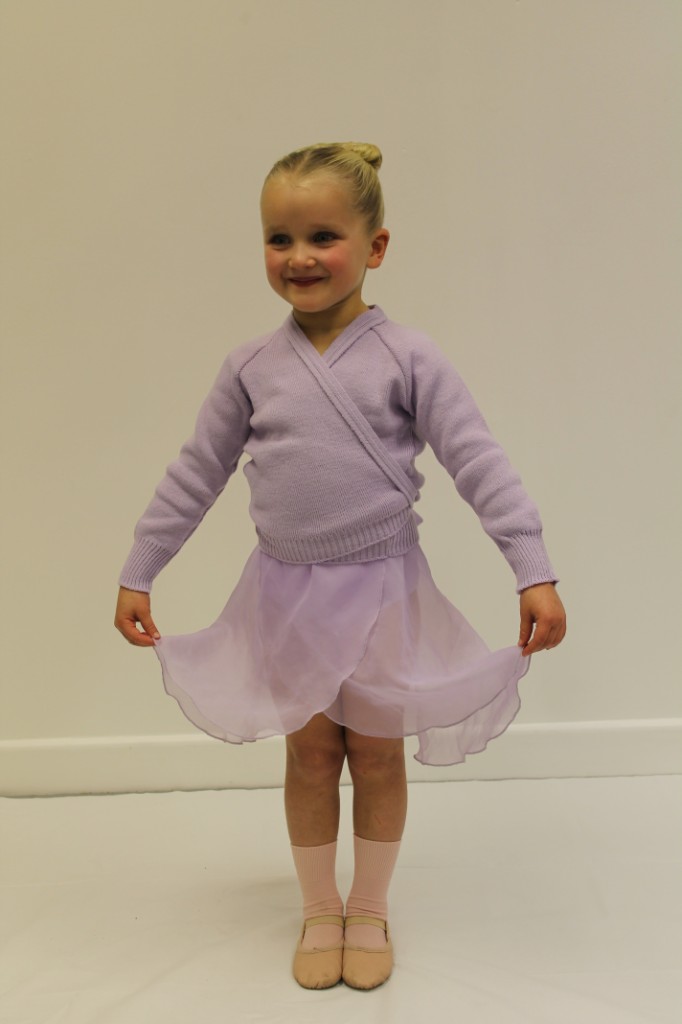
I am sure that all of you know this already, but speaking as a parent, I know how useful it is sometimes to be reminded (particularly if you’re on the second or third child and haven’t re-read all the books you so diligently absorbed the first time!).
For many children, being 3-4 is a tricky time - transitions from activity to activity and place to place can be fast and bewildering, and so often the grown-ups don’t explain ‘properly’ or give an emerging intellect time to absorb and handle the implications of what is happening. These are the reasons why the children are sometimes nervous, tricky, & refuse to participate in things you know they really want to do. Because added to that, this class is without you, their grown up that they depend on love and trust to get them through everything no matter what - you’ve just said good bye at the door and they have to handle it themselves! This is big stuff for a little person!
What we do as teachers is to give them a routine/framework that they can learn, thus allowing them to predict what will happen next, give them ‘rules’ for following that routine, which in effect gives each child control over themselves and their participation. This is the biggest thing we can do for them, as control is what is most often sought at this tender age - if they can predict the start of the class (register and news swapping), understand what is happening during the class and what is expected of them (neat feet when the music stops, no talking when the music is playing, etc), and then be helped to cool down and prepare the transition into leaving (curtsey and bow), then they are relaxed, happy, in control and thus confident in being by themselves - the studio has become their space and not yours.
Things are upsetting when a few specific things go wrong. If you are late arriving, for example. A couple of minutes is probably OK, but even then, they may have missed the register circle and that first chance to bond with the group, so they will be walking into what is a big empty room for a 3 year old, and crossing the floor to the teacher who might be at the other side of it - and that’s massively scary, as all the other children will be staring at them, and some of us are just not that brave! Linked to late arrival is if the door opens and closes constantly or someone is very upset at the door, then that can make an otherwise happy child suddenly very unsettled - we are teaching these children to care about each other, learn from each other and look after each other. Finally, not being there part-way through class if they come out to go to the loo is also upsetting for them, as they don’t expect you to have gone away! There’s always someone in the studio to help with practicalities, this is just their point of view that I’m describing.
This isn’t an exhaustive list, and of course the majority of children can’t wait to get shot of their parents at the door! It takes time to achieve a happy level of confidence, and every child is different - some won’t get there until they are age 5 and some will have it at age 3 - but we have room for every kind of individual in our classes here.
So what is best? Just a few simple things:
- Get here in good time, or a little early - if your class is 9.30, then get here at 9.20, get changed, perhaps read a story, or let your little one chat to their teacher or help set up the studio (which you must not enter unless invited!)
- If your little one is struggling to separate, then hand them into the arms of the teacher, so they can sit on the lap of the teacher to help with the transition into someone else’s care
- Tell them exactly where you will be during the class and that you can’t wait to hear about what they learned at the end
What we will do
- Keep doing what we are doing in the class to support their needs and inspire them to movement and free expression with confidence
- Work with individual families who need little adjustments (such as receiving into our laps those who are less confident)
- Support the transition at the start and end of class with a regular and predictable routine
If any of you have any specific questions relating to your own child, then please phone and speak to me or to your teacher or send me an email.
Starting Pointework - some preparatory notes 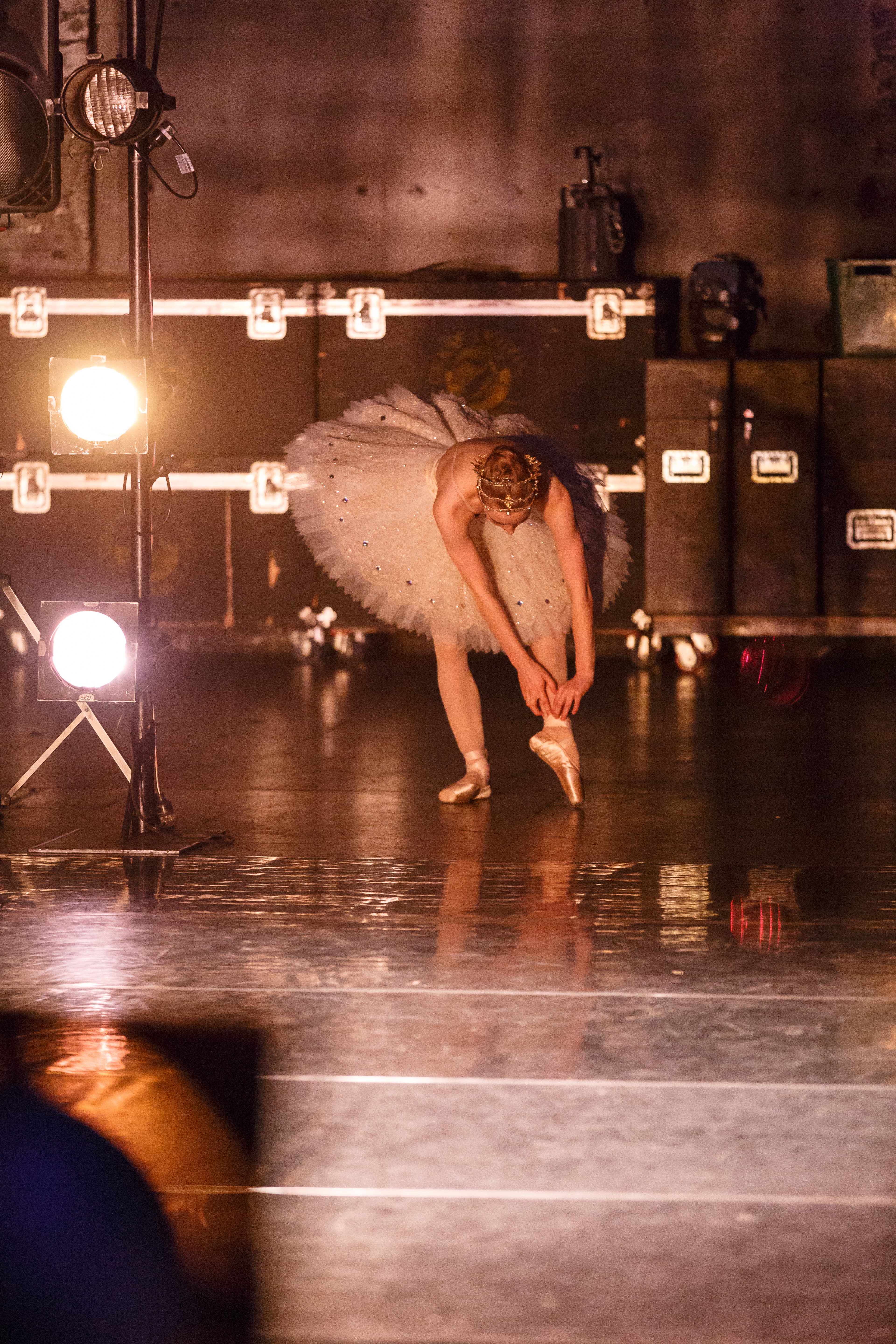
Starting pointework is a very exciting moment in a young dancer’s life. Almost any well-trained dancer can take to pointework, discovering the highs and the lows that this very particular part of a dancer’s skillset offers. It is not for everyone, and that's OK. You are still a dancer if you don't do pointework!
For everyone, no matter physique or commitment, pointework is hard work. In order to balance successfully on about 1½ square inch of glued canvas, and make it look easy, all the leg and foot bones & muscles need to be active and aligned, the body core muscles need to be well-balanced and held correctly and yet the head and arms must be relaxed and able to flow - because it is the arms and expression that makes it look easy!
We believe that pointework may be danced by anyone. Traditionally it is seen most often danced by female dancers. However, there is a very fine company of male dancers who dance en pointe called 'Les Trocaderos'. We believe our role is to help people learn to dance and to reach their full potential, and we will help guide any individual in their own pathway, including pointework.
At Colours of Dance, we assess carefully and thoroughly for suitability for pointework and include specific assessment benchmarks that students must work towards and reach before being invited to start pointework. To be eligible, you should be attending at least two lessons per week at G4 standard or above plus the pointework class, or you are attending 2 graded classes at G4 or above plus one or two vocational graded ballet classes, and possibly also the pointework class each week. It is not really safe to dance en pointe unless you are dancing enough time each week to support strength and technique, particularly during adolescence. The assessment is formal, inclusive and may be repeated as many times as is useful until you are en pointe!
Preparing the legs and feet
This started way back in Pre-Primary, with feet and leg exercises, learning how to stretch the toes and feet in line with the knee and hip, learning how to articulate the toes and control the knees using the thigh muscles. It continued through the grades as the foot gained strength using resistance exercise such as glisses and tendus. The preparation continued with the learning how to execute good releves and controlling the landing from jumps, getting good at feeling all parts of the foot, keeping the knees in line to demonstrate good turnout, whilst holding the back and head upright on each landing. As the middle grades came along, learning to do a developpe in the centre, holding the back, sides and stomach indicates very clearly how much the upper body in involved in maintaining balance and poise. So that’s all in the background.
As the feet & body develop, your teacher will indicate to you when is the right time to consider working in ‘soft-pointes’. These are shoes made similarly to pointe shoes, but without the strong sole (known as the ‘back’). These shoes have a soft box around the toes which needs to be worked in and on until they become properly broken in to fit the foot well and not make a taping sound. They introduce the dancer to the feeling of pointe shoes, and strengthen the intrinsic muscles of the foot further, as the soles and box do make it harder to show a well-pointed foot. This also teaches the student how important the lifting of the instep and lengthening of the ankle is to create the right line and develop even strength down both sides of the whole leg into the foot. A dancer should spend at least 6 months in soft pointe shoes before moving to full-pointe, and in that time, rises and releves will become very important and very regular.
Preparing the skin/dealing with blisters
Everyone who takes up pointework will get sore feet & legs from time to time. Hopefully mostly it is a positive soreness – that great feeling when your body has worked hard and achieved something. However, there will also come the irritating sorenesses, such as blisters and pinched skin. Your teacher will discuss various ways of minimizing these as they are almost always caused by overuse or poorly fitting shoes.
Once ‘en pointe’ it is essential to continue with good foot care and sensible use of relaxation exercises as much as strengthening exercises! For example, keeping toe nails short and cut straight across with a little attention to the corners of the nail if they dig in (varies from foot to foot), tending to sore patches and blisters sensibly and immediately. Bathing feet regularly in a little warm water that has a capful of surgical spirit in it will help toughen the skin and resist blisters or sore areas. It will also help keep them clean and whilst it may sting, it will also help with the healing process when a blister or sore patch arrives. And talk to your teacher. Keep them in the loop on how you’re feeling or coping and they will support you, using their own experience to understand what is normal and what might need some additional treatment or adjustment.
Buying Pointe Shoes
Your teacher will advise you when you are ready to go 'en pointe’. It will mean a trip to a specialist dance shop, where you book an appointment and are fitted by a properly trained pointe shoe fitter, who has access to many types and makes of shoe, and will make sure they find the right shoe for your feet. Ideally your teacher will be able to come with you, but if not, then you will show your teacher before sewing any ribbons on, as your teacher has the final say and knows you best!
Ask lots of questions before you go to buy shoes, and ask even more questions when you are in the shop. They should be happy to help you try on as many pairs of shoes as is necessary to find the perfect pair. They should also ask you lots of questions, to understand how you work (they may already know your teacher), how the shoes feel on your foot, what the box feels like around your foot and so on. You should be offered a shoe that is suitable for the first time wearer - it is softer than a standard shoe and will not last as long, but that is the correct process. These first shoes become your next pair of soft pointes and your second pair will have a stiffer sole and possibly a harder box.
You are looking for a shoe that fits the profile of your foot well, from every angle. The 'box' of the shoe should slope in line with your foot as it lies accross the metatarsal and not bulge upwards above the toes, the heel of the shoe should be equal to the level of your normal shoes, so that you can pass through demi pointe without the heel slipping off the back of your foot.
You should not assume you will need vast amounts of padding - some lambswool yes, and depending on your foot, some toe supports or separators, but a thick 'ouch pouch' will squeeze the toes, cause you to purchase a shoe that is half a size too big in order to fit it all in, and will ensure your contact with the floor is lost.
Understanding the shoes
Pointe shoes are a tool – as well as an instrument of torture and item of reverence! 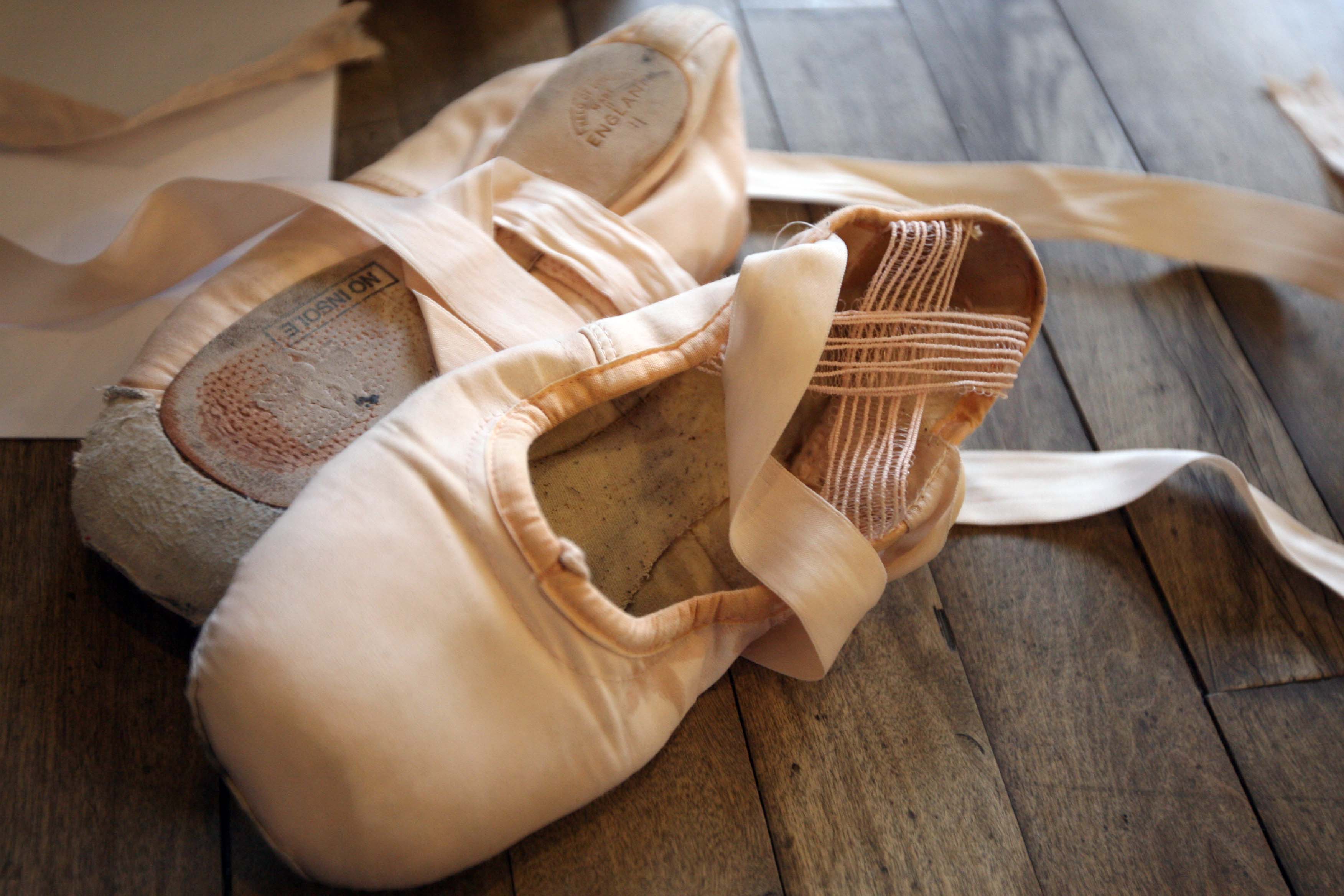 So as with any tool, it is best to understand how it is made, and how to use it best when setting out. Your teacher should explain all the various parts of the shoe (this will be repeated at your fitting) so that you can understand where the support from the shoe should be to facilitate your particular physique. Pointe shoes are made in a variety of different ways, and modern technology has in some ways changed their manufacture considerably and in others not at all (ie most of the finishing is all handmade even now).
So as with any tool, it is best to understand how it is made, and how to use it best when setting out. Your teacher should explain all the various parts of the shoe (this will be repeated at your fitting) so that you can understand where the support from the shoe should be to facilitate your particular physique. Pointe shoes are made in a variety of different ways, and modern technology has in some ways changed their manufacture considerably and in others not at all (ie most of the finishing is all handmade even now).
The main things in a pointe shoe to consider are the shape of the box (short, long, slim, rounder, square, broad, narrow etc), the length of the vamp (the extension of the box up the side of the foot) versus the length of your toes and the shape of your metatarsal, the length and relative stiffness of the ‘back’ (sole of the shoe).
Understanding balance
In simple terms, everything you do well in flats will be OK ‘en pointe’, but every fault you have in your posture and balance will be ten times worse ‘en pointe’! This is why your teacher will take time to prepare you with preparation exercises before you start pointe work, so that you can identify the particular adjustments you need to make and muscles you need to use to have a successful transition from the demi to the full pointe. So please take it slowly and listen carefully to your teacher!
Starting the RAD Grades at Colours of Dance 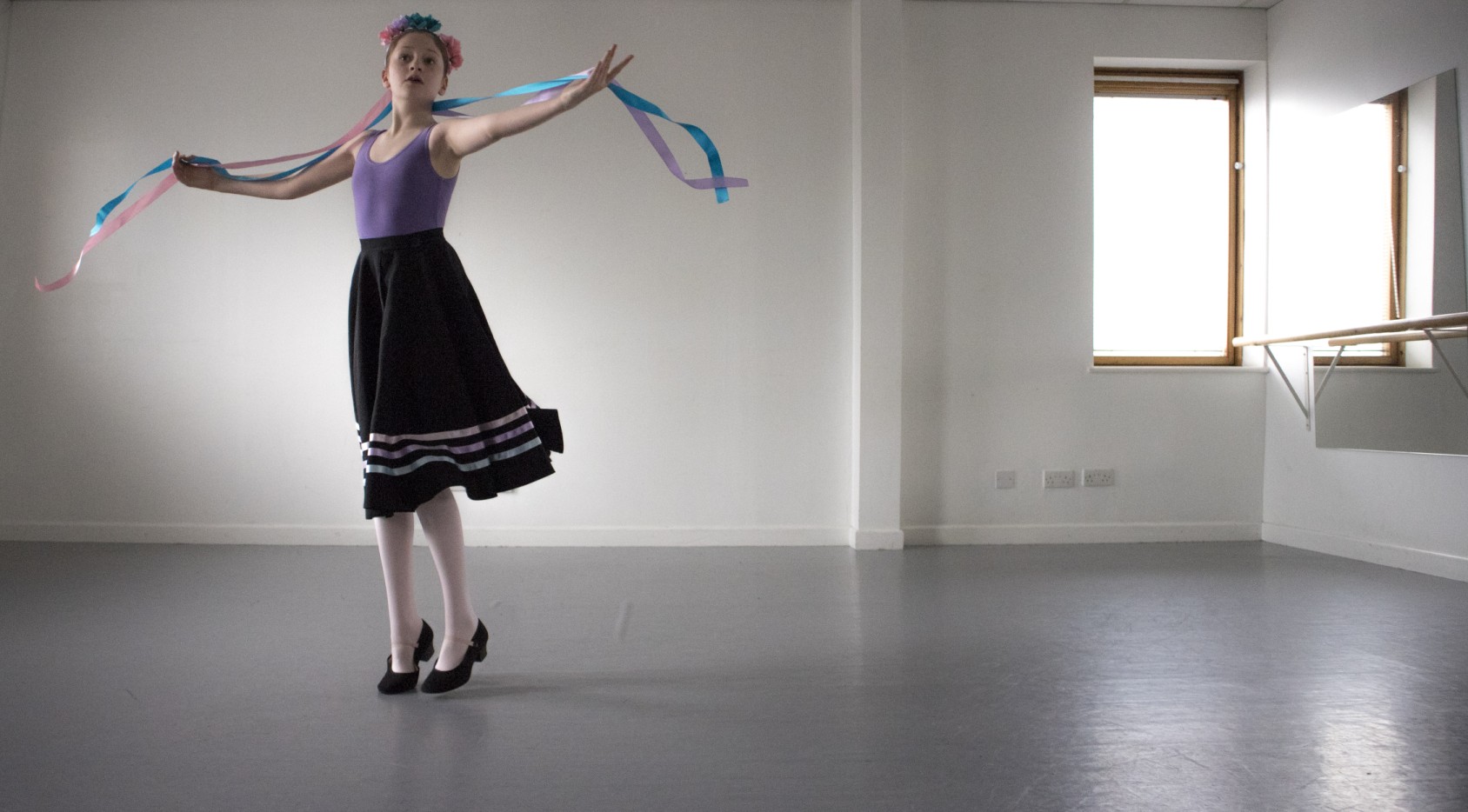
For Parents with children about to enter the RAD Grade 1 or higher Ballet class.
Grade 1 can be considered quite a rite of passage, as it is the first of 8 grades they can work though, which depending on their interest as time passes, will keep them dancing and progressing right up until they start college!
In all the RAD grades, the methodology is sound, safe and continuously challenging. It is not an absolute requirement to take each exam before progressing to the next grade, but it is recommended, as preparing for an exam is part of preparing for entering the next level, in terms of strength, coordination, technical consistency and presentation. As an RAD teacher, I will introduce the developmental exercises each week and explain how we are building these up, before hoping them to prepare a series of set exercises and dances for examination.
The syllabus is founded and centred on classical ballet technique. However, it also introduces some contemporary concepts, which are becoming ever more normal and relevant for today’s professional dancers and choreography. An example of this is the ability to dance in both turned in and turned out positions, switching between the two regularly and quickly within the same series of steps. It also encompasses a breadth of movement and imaginative approach to new movement which is less ’set’ than the standard classical steps. In addition to this, the students are introduced to 'Character Dance’. These steps are based on European folk steps and styles of dance, and can be found in the ‘divertissement’ acts in the traditional ballet such as Sleeping Beauty, Nutcracker and Swan Lake. The RAD have kept these steps in the syllabus, as it’s part of the ballet education as long as the ballets are found in company repertoire. These dances are also fun, full of personality and provide an opportunity for personalities to shine out and demonstrate a bit of fancy footwork!
So what does all this mean for your little dancer, about to step into the studio?
Firstly, girls will need to start to learn how to put their hair into a bun. Turning becomes more and more important from Grade 1, and they need to be able to spot with their eyes, not have anything flicking into their faces or those of others around them. If your daughter has very flyaway hair, then you should consider a hairband or clips to help keep these away from her eyes. Also, boys with longer hair or long fringes must also tie their hair back with clips or an elastic.
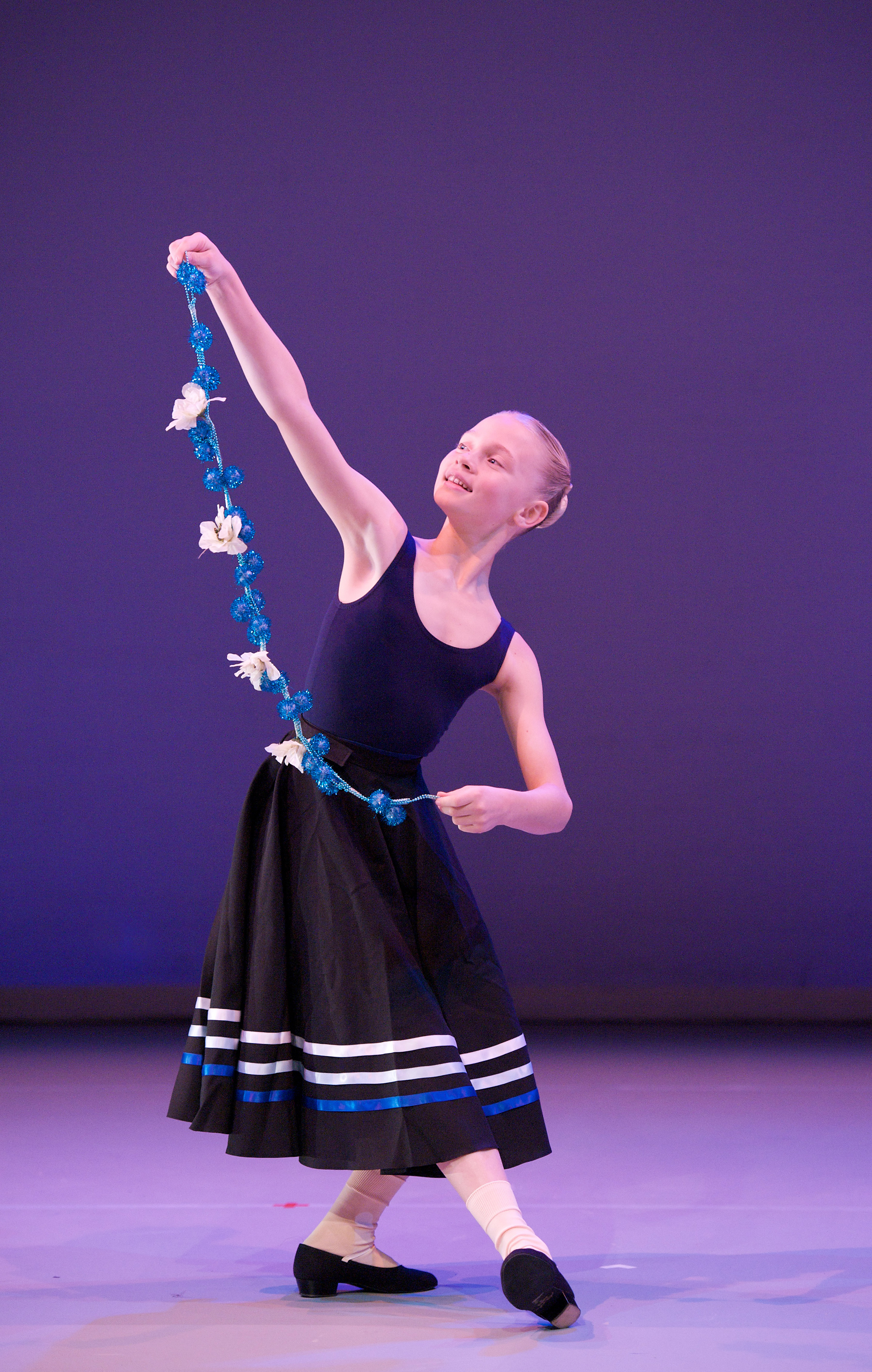 Secondly, the children will all need character shoes. For girls this is a heeled 'mary-jane' style shoe in black canvas with pink elastic. For boys, this is a heeled ‘Oxford’ style lace up in black canvas. I suggest swapping the black laces for black elastic, so that they can slip in and out of them quickly while they are learning to tie their laces. The girls will also need a black character skirt, although if you’re staging the costs, the shoes should come first!
Secondly, the children will all need character shoes. For girls this is a heeled 'mary-jane' style shoe in black canvas with pink elastic. For boys, this is a heeled ‘Oxford’ style lace up in black canvas. I suggest swapping the black laces for black elastic, so that they can slip in and out of them quickly while they are learning to tie their laces. The girls will also need a black character skirt, although if you’re staging the costs, the shoes should come first!
Third, there’s a change in uniform, for both boys and girls. For boys, they move into white leotard and navy leggings, keeping their white socks and shoes, and for girls, they change to a short-sleeved leotard with belt in lavender, again, keeping their pink socks and shoes. (Tights may be worn by girls from grade 3).
Finally, they may appreciate a ballet notebook and pencil, so they can write down their class feedback, the proper name of a step, or anything else that will improve their knowledge or help them remember things!
From Grade 2 and above, they may wish to attend twice a week. By this stage, they know they really like ballet, perhaps better than any other hobby, and even if not, they like progressing at a grade per year. From Grade 2, it’s not possible to progress at this rate without coming twice a week. If your child only wants to come once a week, that’s totally OK with us, but you and they should understand that each grade takes about 5-6 terms, so it will take a little longer to get to Grade 3 and so on. This does suit many children - after all, it’s not a competition! Any child is welcome to come to more than 1 ballet class a week, whatever their grade, and in all cases, this will have the result of faster improvement of course.
I hope you have found this information helpful, but if you have any questions at all, please do not hesitate to ask me or your regular ballet teacher.
Getting the Best out of your Dance Class – and your Teacher!
It sometimes strikes me as a teacher that there isn’t really enough time to share everything I want to every week with every student! And I am absolutely sure that a lot of students feel too that they want to do more, ask more, practise more. I also feel sometimes that there are those students who would like to get more out of their lessons, or progress faster, but they don’t know how or what to ask or do about it. So I’ve had a good think and talked to my colleagues about this a bit, and hopefully these ideas that follow will be useful, all or in part, to both students and parents of all ages and dance genres.
Get a good night’s sleep and arrive in class really ready to go for it! It seems obvious, but having enough energy (both mental and physical) for a physical activity is really important. While dance is not a sport, some of the same ideas apply. Students will expend both mental and physical energy in their dance classes, so in order to be able to be alert, enthusiastic and responsive, they will need to have stocked up on food, drink and sleep, so they’re like mini-racehorses hopping at the gate. This applies no matter the age of the student.
Don’t stand next to your friend if you will chat! Dance class is definitely a friendly and social learning environment, but it’s not really a play date!
Have a goal in mind for your lesson. It is useful to have both small targets and larger ones that take longer to get to. It’s quite easy set your own short target, but you may want to have a chat with your teacher to set yourself a longer-term target. Examples of what targets might be are as follows:
- Learn one thing really well today (small)
- Learn a name for a step (small)
- Hold my posture well for the whole lesson (small)
- Improve my arm line (large)
- Be able to do the splits on both legs (large)
- Be able to switch quickly between styles so I can be confident and clear about my communication (large)
Be curious. You will learn all sorts of steps, skills, styles, moods, exrecises and dances in your classes. Some things you will feel fit you like a glove and you can't get enough of it, whilst other things you find hard or don't like so much. Learn as much detail as you can about what you are learning - the names of the steps, how they fit together, what they look like on different people - whether it is something you like or something you don't - this way you will get caught up in your dance and you will deliver it better - as well as being able to apply that technique to the next level.
Learn to take feedback as 'useful information'. Many dancers can be hyper-self-critical, and many young people can find it very difficult to understand and receive feedback. At Colours of Dance, we work with all ages and types of students, and we try very hard to find myriad ways to give feedback in a supportive, open, constructive and positive way, to benefit the student so that they can learn and take control of their own learning. Students can really assist in this by listening hard, receiving feedback as interest and commitment from their teacher and not criticism, and when they don't understand something, buy asking questions or asking their teacher to repeat the information.
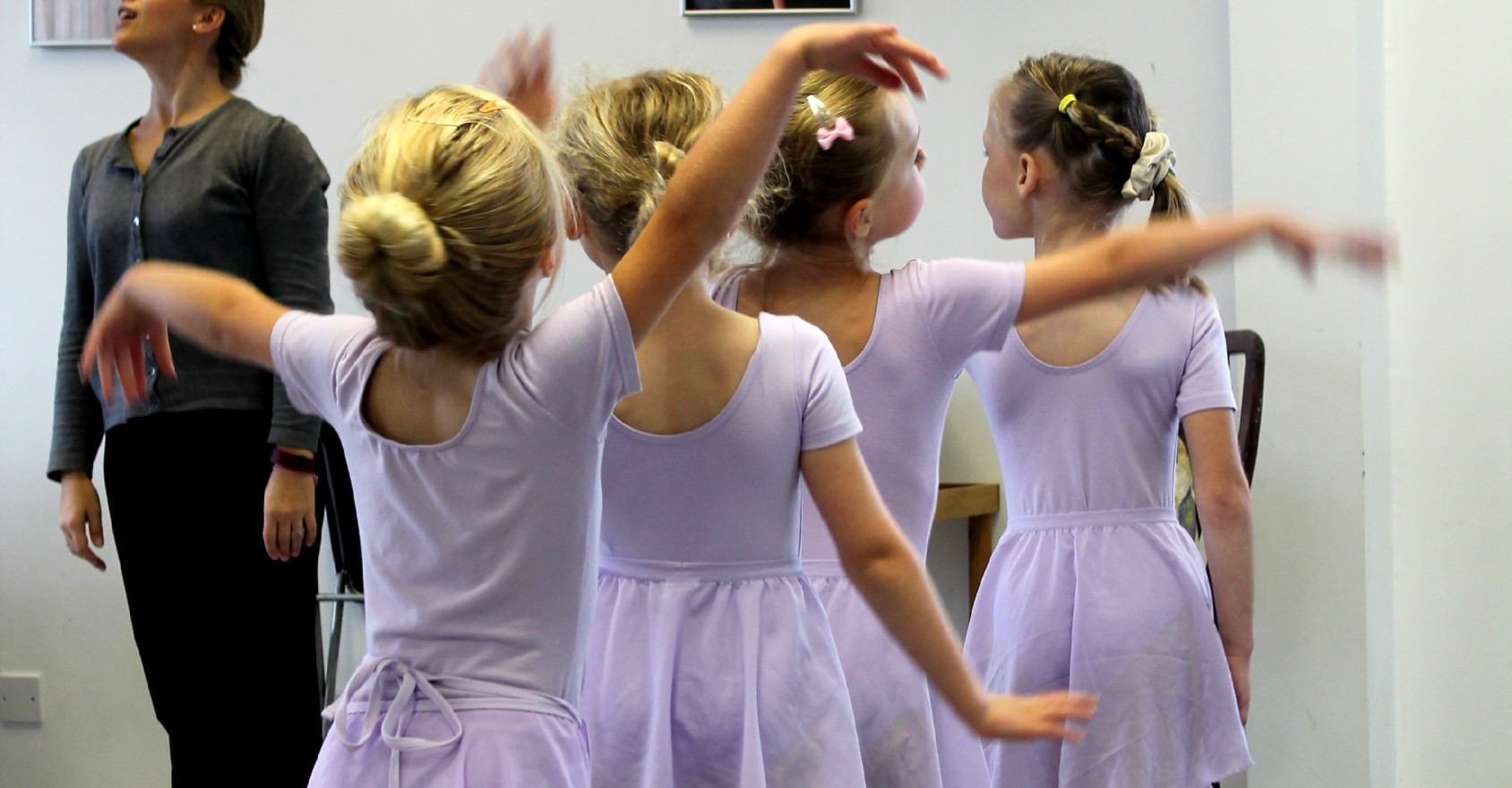
The Mark of a Good Teacher
Dance schools form what the government terms an 'Out Of School Setting', and whilst these settings are not regulated, there are guidelines for good practice. These guidelines also include advice for what parents can look for in a quality provider.
You can find these guidelines here: https://www.gov.uk/government/publications/guidance-for-parents-and-carers-on-safeguarding-children-in-out-of-school-settings
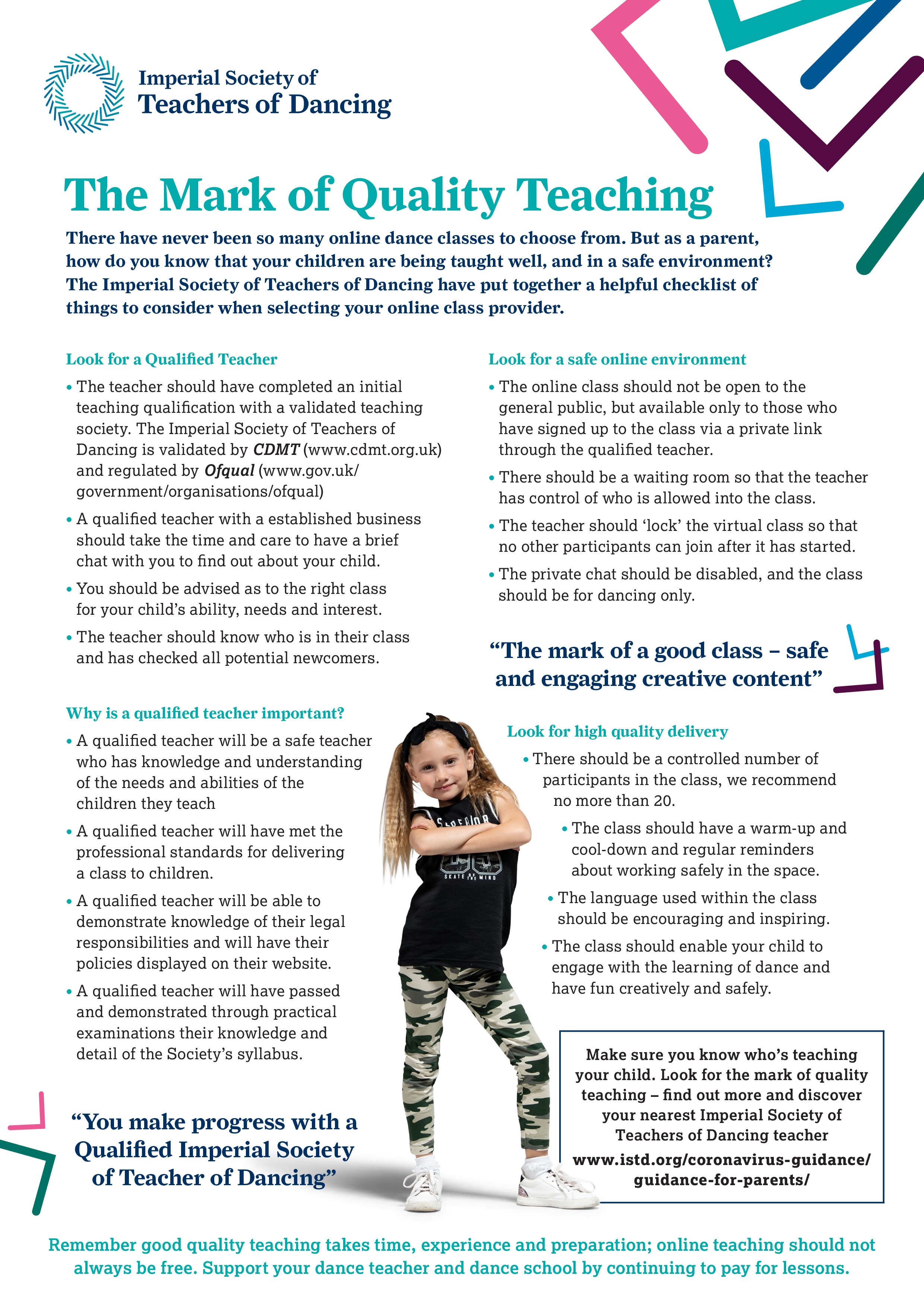
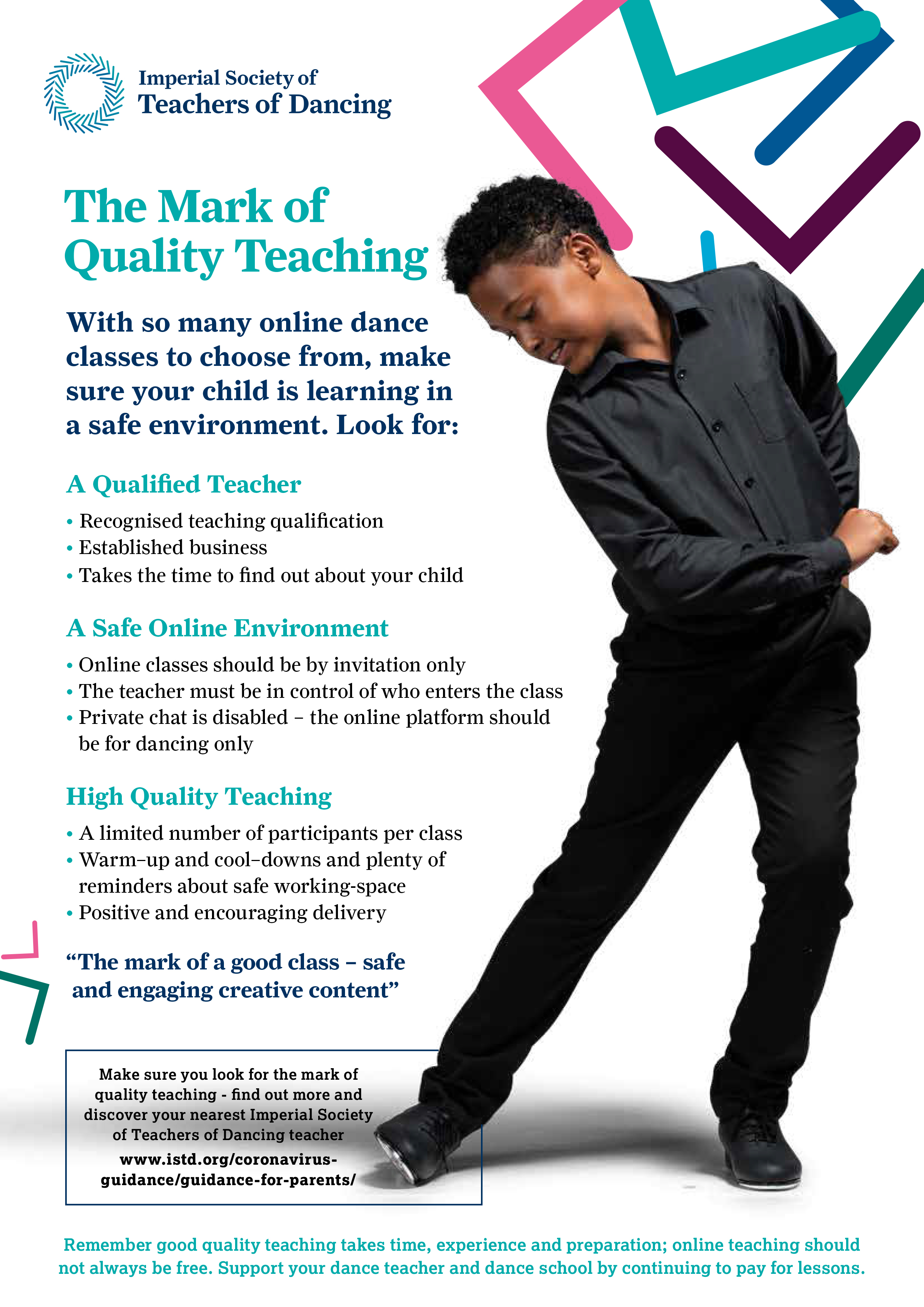
It is important that you as parents know that your child is getting the best quality of teaching in a safe environment.
ISTD have created guidelines for parents and a poster for their members to show parents about these guidelines. The initiative is designed to reassure you that as reputable teachers and members of the ISTD, at Colours of Dance, we are doing our best to give you what we promised and also what is expected.
Here is a checklist for you to check that we are giving our best and following guidelines. If you click on either of these images, they will take you to the ISTD website where you may read more information.
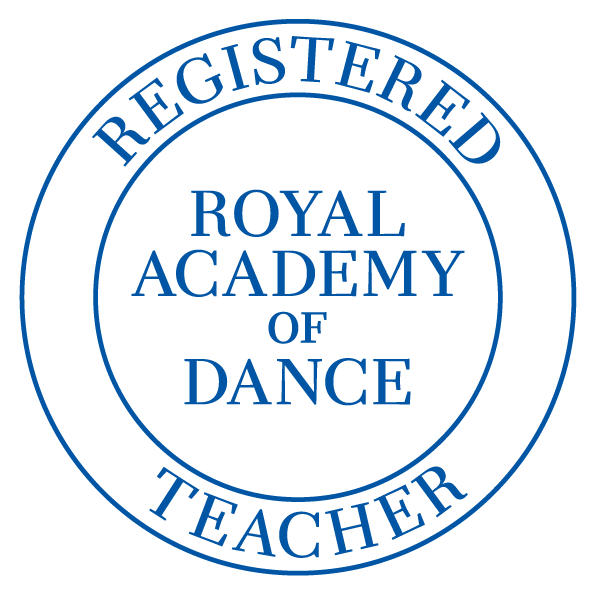 All RAD teachers are required to know and abide by a Code of Professional Practice (you may read this here: RAD Code of Practice), re-affirming this each year at renewal of their teaching membership.
All RAD teachers are required to know and abide by a Code of Professional Practice (you may read this here: RAD Code of Practice), re-affirming this each year at renewal of their teaching membership.
At Colours of Dance, we incorporate the standards that both these organisations have set as professional leaders in dance education, and we have a code of conduct for all our teachers and staff, in addition to the Ethos for the school, as written and set by our Principal, Miss Imogen. Staff meet formally regularly and talk constantly to each other, to try to ensure that however you experience Colours of Dance, you will receive an honest, professional and positive experience of dance. Our teachers have a variety of backgrounds, many of whom are registered with either or both the RAD and ISTD, or who qualified as teachers with other organisations. You can see detailed bios for each of our teachers on their pages: Teachers - Bios.



 So as with any tool, it is best to understand how it is made, and how to use it best when setting out. Your teacher should explain all the various parts of the shoe (this will be repeated at your fitting) so that you can understand where the support from the shoe should be to facilitate your particular physique. Pointe shoes are made in a variety of different ways, and modern technology has in some ways changed their manufacture considerably and in others not at all (ie most of the finishing is all handmade even now).
So as with any tool, it is best to understand how it is made, and how to use it best when setting out. Your teacher should explain all the various parts of the shoe (this will be repeated at your fitting) so that you can understand where the support from the shoe should be to facilitate your particular physique. Pointe shoes are made in a variety of different ways, and modern technology has in some ways changed their manufacture considerably and in others not at all (ie most of the finishing is all handmade even now). 
 Secondly, the children will all need character shoes. For girls this is a heeled 'mary-jane' style shoe in black canvas with pink elastic. For boys, this is a heeled ‘Oxford’ style lace up in black canvas. I suggest swapping the black laces for black elastic, so that they can slip in and out of them quickly while they are learning to tie their laces. The girls will also need a black character skirt, although if you’re staging the costs, the shoes should come first!
Secondly, the children will all need character shoes. For girls this is a heeled 'mary-jane' style shoe in black canvas with pink elastic. For boys, this is a heeled ‘Oxford’ style lace up in black canvas. I suggest swapping the black laces for black elastic, so that they can slip in and out of them quickly while they are learning to tie their laces. The girls will also need a black character skirt, although if you’re staging the costs, the shoes should come first!


 All RAD teachers are required to know and abide by a Code of Professional Practice (you may read this
All RAD teachers are required to know and abide by a Code of Professional Practice (you may read this